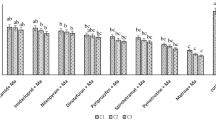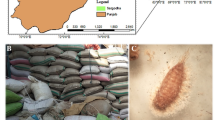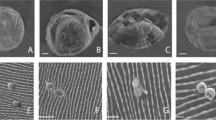Abstract
Our aim was to evaluate the efficacy of combinations between two biorational insecticides (luphenuron, methoxyfenozide), a new synthetic chemical pesticide (rynaxypyr), and three entomopathogenic fungi strains (Beauveria bassiana LPSc 1067, LPSc1082), and Metarhizium anisopliae (LPSc 907) in the biocontrol of the pest grasshopper Ronderosia bergi (Stål) under laboratory conditions. The insecticides were tested at three concentrations: the average concentration recommended for application in the field (100 %) and 50 % and finally 25 % of that level. The fungal strains used were adjusted to 1 × 108, 1 × 106, and 1 × 104 conidia ml-1. The combinations of those insecticides with B. bassiana (LPSc 1067, LPSc 1082) and M. anisopliae (LPSc 907) caused higher mortality to R. bergi nymphs than any of the individual agents used alone. The three insecticides tested did not affect the isolates of the two species of entomopathogenic fungi employed. In conclusion, the use of these biorational insecticides in an IPM program aimed at control of the grasshopper R. bergi could be of value.

Similar content being viewed by others
References
Altschul SF, Gish W, Miller W, Myers EW, Lipman DJ (1990) Basic local alignment search tool. J Mol Biol 215:403–410
Alves SB, Moino A, Almeida JEM (1998) Produtos fitossanitários e entomopatógenos. In: Alves SB (ed) Controle microbiano de insectos. FEALQ, Piracicaba, Brazil, pp 217–238
Anderson TE, Roberts DW (1983) Compatibility of Beauveria bassiana strain with formulations used in Colorado Potato Beetle (Coleoptera: Chrysomelidae) control. J Econ Entomol 76:1437–1441
Bischoff JF, Rehner SA, Humber RA (2009) A multilocus phylogeny of the Metarhizium anisopliae lineage. Mycologia 101:512–530
Bitsadze N, Jaronski S, Khasdan V, Abashidze E, Abashidze M, Latchininsky A, Samadashvili D, Sokhadze I, Rippa M, Ishaaya I, Horowitz AR (2013) Joint action of Beauveria bassiana and the insect growth regulators diflubenzuron and novaluron, on the migratory locust, Locusta migratoria. J Pest Sci 86:293–300
Boucias DG, Stokes C, Storey G, Pendland JC (1996) The effect of imidacloprid on the termite Reticulitermes flavipes and its interaction with the mycopathogen Beauveria bassiana. Pflanzenschutz-Nachr Bayer 49:103–144
CASAFE (2013) Cámara Argentina de Sanidad Agropecuaria y Fertilizantes: Guía de productos fitosanitarios. Tomo 1. CASAFE. Buenos Aires, Argentina
Delgado FX, Britton JH, Onsager JA, Swearingen W (1999) Field assessment of Beauveria bassiana (Balsamo) Vuillemin and potential synergism with diflubenzuron for control of Savanna grasshoppers complex (Orthoptera) in Mali. J Invertebr Pathol 73:34–39
Foster RN, Reuter KC, Black L, Britton J (1996) Evaluation of the fungus Beauveria bassiana with selected insecticide stressors for control of unconfined rangeland grasshoppers. Arthropod Manag Tests 21:280
Gonzalez M, Miglioranza KS, Aizpún JE, Isla FL, Peña A (2010) Assessing pesticide leaching and desorption in soils with different agricultural activities from Argentina (Pampa and Patagonia). Chemosphere 81:351–358
Hassan AEM, Charnley AK (1989) Ultrastructural study of the penetration by Metarhizium anisopliae through Dimilin affected cuticle of Manduca sexta. J Invertebr Pathol 54:117–124
Henry JE (1985) Melanoplus spp. In: Singh P, Moore RF (eds) Handbook of Insect Rearing. vol. 1’. Elsevier, Amsterdam, pp 451–464
Horowitz AR, Ishaaya I (2004) Insect pest management-field and protected crops. Springer, Berlin, Germany
Inglis GD, Johnson DL, Goettel MS (1996) Effect of bait substrate and formulation on infection of grasshopper Nymphs by Beauveria bassiana. BioControl Sci Technol 6(1):35–50
Jager T, Heugens EHW, Kooijman SALM (2006) Making sense of ecotoxicological test results: towards application of process-based models. Ecotoxicology 15(3):305–314
Jaronski ST (2010) Ecological factors in the inundative use of fungal entomopathogens. Biocontrol 55:159–185
Lacey LA, Brooks WM (1997) Initial handling and diagnosis of diseased insects. In: Lacey LA (ed) Manual of techniques in insect pathology. Academic Press, San Diego, USA, pp 1–15
Lane BS, Humphreys BSAM, Thompson K, Trinci APJ (1988) ATP content of stored spores of Paecilomyces farinosus and the use of ATP as criterion of spore viability. Trans Br Mycol Soc 90:109–111
Lange CE (1996) Protistas patógenos de insectos terrestres. In: Lecuona R (ed) Microorganismos patógenos empleados en el control microbiano de insectos plaga. Mariano Mas, Buenos Aires, Argentina, pp 87–104
Lomer CJ, Bateman RP, Johnson DL, Langewald J, Thomas M (2001) Biological control of locust and grasshoppers. Annu Rev Entomol 44:667–702
Mariottini Y, De Wysiecki ML, Lange CE (2010) The biology and population parameters of the grasshoppers Ronderosia bergi under laboratory conditions. J Insect Sci 10:92
Mariottini Y, De Wysiecki ML, Lange CE (2011) Seasonal occurrence of life stages of grasshoppers (Orthoptera: Acridoidea) in the southern pampas, Argentina. Zool Stud 50(6):737–744
Mascarin GM, Kobori NN, Quintela ED, Arthurs SP, Júnior ID (2014) Toxicity of non-ionic surfactants and interactions with fungal entomopathogens toward Bemisia tabaci biotype B. BioControl 59:111–123
Moino AR, Alves SB (1998) Efeito de Imidacloprid e fipronil sobre Beauveria bassiana (Bals.) Vuill. e Metarhizium anisopliae (Metsch.) Sorok. e no comportamento de limpeza de Heterotermes tenuis (Hagem). An Soc Entomol Brasil 27:611–619
Moore D, Reed M, Le Patourel G, Abraham YJ, Prior C (1992) Reduction of feeding by the desert locust, Schistocerca gregaria, after infection with Metarhizium flavoviride. J Invertebr Pathol 60:304–307
Neves PMOJ, Hirose E, Tchujo PT, Moino A (2001) Compatibility of entomopathogenic fungi with neocotinoid insecticides. Neotrop Entomol 30(2):263–268
Nishimatsu T, Jackson JJ (1998) Interaction of insecticides, entomopathogenic nematodes, and larvae of the western corn rootworm (Coleoptera: Chrysomelidae). J Econ Entomol 91(2):410–418
Oliveira CN, Neves MO, Kawazoe LS (2003) Compatibility between the entomopathogenic fungus Beauveria bassiana and insecticides used in coffee plantations. Sci Agric 60(4):663–667
Paula AR, Carolino AT, Paula CO, Samuels RI (2011) The combination of the entomopathogenic fungus Metarhizium anisopliae with the insecticide Imidacloprid increases virulence against the dengue vector Aedes aegypti (Diptera: Culicidae). Parasit Vectors 4:1–8
Pelizza SA, Eliades LA, Scorsetti AC, Cabello MN, Lange CE (2012a) Entomopathogenic fungi from Argentina for the control of Schistocerca cancellata (Orthoptera: Acrididae) nymphs: fungal pathogenicity and enzyme activity. Biocontrol Sci Technol 22(10):1119–1129
Pelizza SA, Eliades LA, Saparrat MCN, Cabello MN, Scorsetti AC, Lange CE (2012b) Screening of Argentine native fungal strain for biocontrol of the grasshoppers Tropidacris collaris: relationship between fungal pathogenicity and chitinolytic enzyme activity. World J Microbiol Biotechnol 28:1359–1366
Pelizza SA, Mariottini Y, Russo ML, Cabello MN, Lange CE (2013) Survival and fecundity of Dichroplus maculipennis and Ronderosia bergi (Orthoptera: Acrididae: Melanoplinae) following infection by Beauveria bassiana (Ascomycota: Hypocreales) under laboratory conditions. Bicontrol Sci Technol 23(6):701–710
Péry AR, Flammarion P, Vollat B, Bedaux JJ, Kooijman SA, Garric J (2002) Using a biology-based model (DEBtox) to analyze bioassays in ecotoxicology: opportunities and recommendations. Environ Toxicol Chem 21(2):459–465
Quintela ED, Mascarin GM, Da Silva RA, Barrigossi JAF, Martins JF (2013) Enhanced susceptibility of Tibraca limbativentris (Heteroptera: Pentatomidae) to Metarhizium anisopliae with sublethal doses of chemical insecticides. Biol Control 66:56–64
Rehner SA, Buckley E (2005) A Beauveria phylogeny inferred from nuclear ITS and EF1 a sequences: evidence for cryptic diversification and links to Cordyceps teleomorphs. Mycologia 97:84–98
Reuter KC, Foster RN, Black L, Britton J (1996) Laboratory evaluation of Beauveria bassiana with an added chemical stressor. Arthropod Manag Tests 21:415–416
SAS/STAT® Version 8. The GLM Procedure (2001) SAS Institute Inc. SAS Campus drive, Cary, North Carolina, USA
Stenglein S, Balatti P (2006) Genetic diversity of Phaeoisariopsis griseola in Argentina as revealed by pathogenic and molecular markers. Physiol Mol Plant Pathol 68:158–167
van Driesche RG, Hoddle MS, Center TD (2007) Conservación de los agentes de control biológico en los cultivos. In: van Driesche RG, Hoddle MS, Center TD (eds) Control de plagas y malezas por enemigos naturales. Forest Health Technology Enterprise Team, USA, pp 391–429
Xlstat Life Software (2014) Version 2014.1.01. Addinsoft SARL Paris, France. http://www.xlstat.com
Acknowledgments
This study was partially supported by Consejo Nacional de Investigaciones Científicas y Tecnológicas (PIP 0009), Comisión de Investigaciones Científicas de la provincia de Buenos Aires (CICPBA), and Universidad Nacional de La Plata (UNLP, 11/N 651). Marta Cabello and Carlos E. Lange are researchers from CICPBA. We thank statistician Dra. Celina Beltran, research professor of Universidad Nacional de Rosario, for performing the statistical tests of this investigation and the authors are grateful to Dr. Donald F. Haggerty, a retired career investigator and native English speaker, for editing the final version of the manuscript. We also thank two anonymous reviewers for helpful comments on the manuscript.
Author information
Authors and Affiliations
Corresponding author
Additional information
Handling Editor: Nicolai Meyling.
Rights and permissions
About this article
Cite this article
Pelizza, S.A., Scorsetti, A.C., Fogel, M.N. et al. Compatibility between entomopathogenic fungi and biorational insecticides in toxicity against Ronderosia bergi under laboratory conditions. BioControl 60, 81–91 (2015). https://doi.org/10.1007/s10526-014-9606-7
Received:
Accepted:
Published:
Issue Date:
DOI: https://doi.org/10.1007/s10526-014-9606-7




